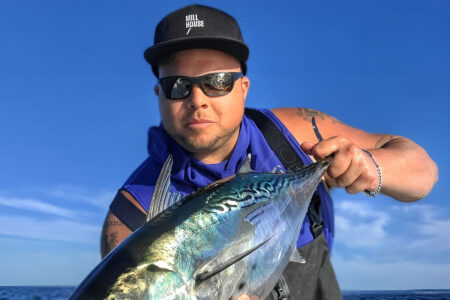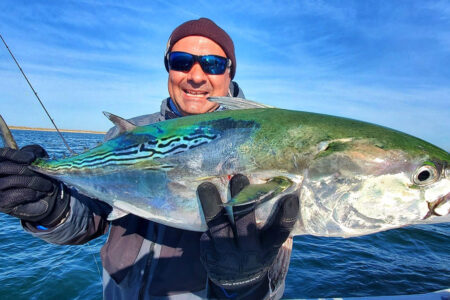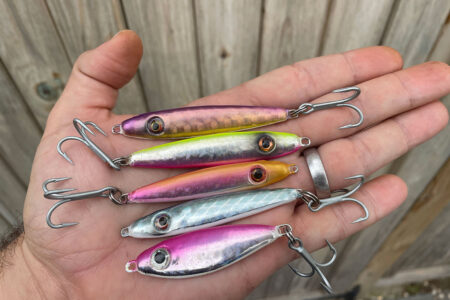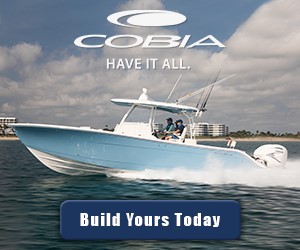Photos by Sean Callinan
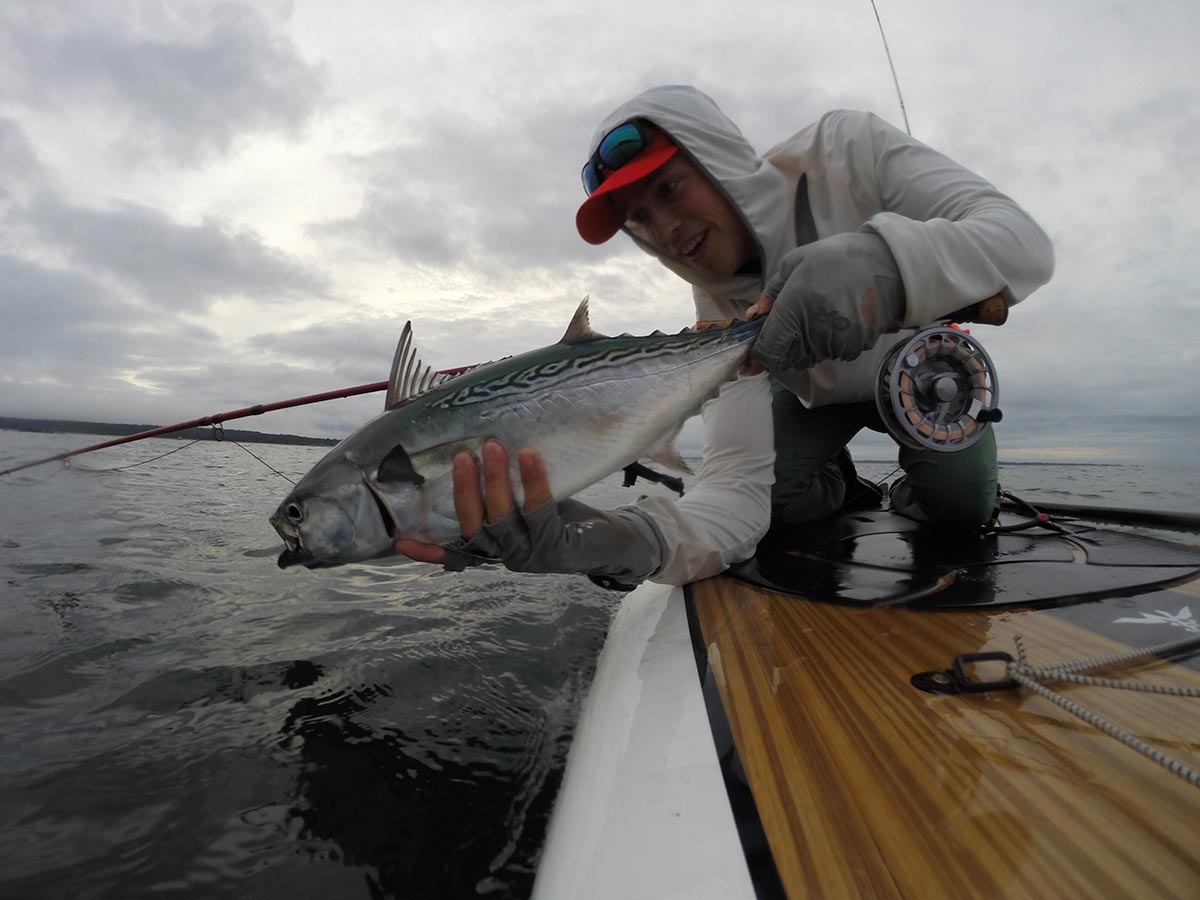
In these days of social distancing, here’s how to try the ultimate sport for false albacore and bonito.
Not sure what to do with yourself for social-distancing fun and exercise this fall? Need some alone time from working at home? Looking for something new to try? Imagine battling the most exciting nearshore gamefish in the Northeast while standing on nothing more than a glorified surfboard. It’s the quintessential social-distancing experience.
Fishing from a stand-up paddleboard or “SUP” provides a challenge and adventure unmatched by any other casting platform. Its benefits are many, and drawbacks are few. Professional paddler Sean Callinan (scallinan1@gmail.com, 203-444-3651) is a licensed guide out of Branford, Connecticut who specializes in offering fishing trips aboard SUPs. Although he also chases stripers and bluefish, his ultimate annual target is false albacore.
“Driving past the beach on Niantic Bay one evening,” says Callinan, “I spotted birds working only 50 feet from shore. I did a quick U-turn, parked, grabbed my paddleboard, fly rod and paddle, and raced to the beach, launching onto the glassy waters. As I feverishly paddled within range, the birds continued diving where the predators corralled bait balls. I knelt, jamming my paddle into its holder and quickly grabbed my rod as I glided into position.
“I made a cast, started my retrieve and felt the tug of a lifetime. A sunset SUP sleigh ride was suddenly underway. After nearly 10 minutes of explosive runs, the false albacore tired. I lifted my rod one last time, exposing the fish’s head, and drew it in. Finally grabbing the leader, the battle was over. I beamed as I dislodged the hook, and then released the magnificent fish. That experience made my season complete.”
First-Time Buyer
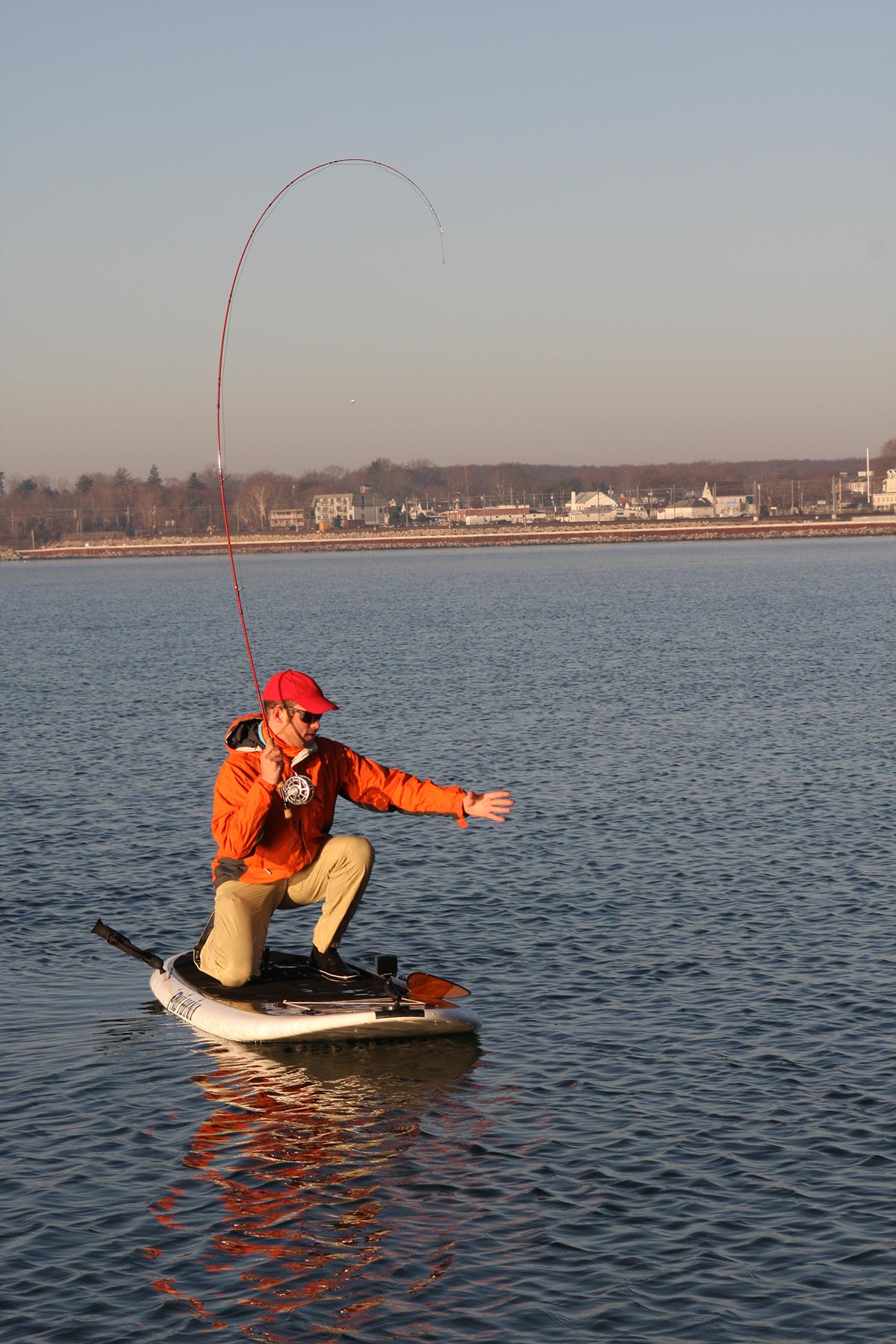
Stand-up paddleboards have leapt to the front of the paddlecraft industry with their ability to get almost anyone out on the water for marginal expense and minimal storage and transportation considerations.
“When shopping for a board,” says Elliott Taylor, a lifelong saltwater angler and recreational sports manager at Yale University, “there are several important things to consider: First is price. Entry-level boards will run between $300-$800 depending on materials, size and intended purpose. I recommend a plastic or composite board for fishing as they are more durable than most fiberglass options.
“Second is carrying capacity. When selecting a board, I recommended buying one with a higher weight rating than necessary. If you’re 180 pounds, for instance, a board rated for 200-plus pounds will provide more stability, especially when also loaded with fishing gear.
“Third is accessories. There’s plenty of aftermarket support for paddleboard add-ons. Among the most important are leashes, both for the paddler and the paddle, and tie-down systems, coolers, and PFDs. While leashes can sometimes get in the way, they ensure that if you fall off, you won’t be stranded as your board drifts away in the wind or current. It’s also a good idea to have a leash on your rod in case of a rollover.
“Self-inflating PFDs are streamlined and provide much more movement and flexibility than the ‘Mae West’ foam options, making them great for paddleboarding. Having a flat-top, hard-sided cooler onboard provides dry storage, a place to mount rod holders, a rigging surface, and it doubles as a seat. It’s also smart to have a small anchor and sufficient rope to prevent drifting either farther from shore or onto the rocks in an emergency.”
A fishing paddleboard is purpose-specific by being longer and wider than other models, which increases stability and provides more room for gear. To prevent unhappy tumbles into the brine, SUP fishing necessitates reasonable balance. If you’ve never been paddleboarding, practice in a bathing suit on calm water during warm weather. Once you’ve achieved a degree of expertise, don some fishing apparel, including your PFD, and with a rod in hand, intentionally drop into the water to practice reacquiring and standing back up on your board—without losing your tackle or gear.
Be aware that due to the pandemic, demand for personal recreational equipment like paddleboards, kayaks, and related accessories have greatly increased. Some companies or stores may be low on inventory or slow to respond, so plan your purchases and adventures accordingly.
Benefits Of Paddleboards
“During these stressful times,” says Taylor, “SUP fishing is a great way to social distance with friends compared to sharing the deck of a boat. You can safely fish with as many buddies as you like because everyone has their own board. You also have a better vantage point for sight-fishing than from a kayak, and can move silently and quickly up to a school without being detected and spooking the fish. Since an SUP is low profile, however, it’s best to wear high-visibility clothing to be better seen by power-boaters. Flashing lights designed for bicycles or runners are a great option for low-light situations.”
When fishing by SUP, you can access almost any coastal shoreline, especially in shallow or rocky spots where you wouldn’t dare venture with your powerboat. You don’t need a ramp because you can launch a paddlecraft anywhere you can access on foot. This ability allows you to discover new and remote spots not accessible by boat or shore fishing. If you’ve ever seen albies or bonito crash prey near the shore you know they’ll feed right up against the rocks or beach, areas sometimes inaccessible by powerboat.
SUPs are quick and easy to transport with a proper roof rack or even inside a large SUV. “I use the Yakima SUPDawg as my roof carrier,” says Callinan. “It’s wide enough for my 36-inch-wide board and has sufficient strapping capacity for two boards. Its Kevlar locking straps prevent theft and are durable enough for highway trips.”
A SUP is much less expensive to purchase and maintain than even a small boat, and there’s no trailering, registration, insurance, fuel or oil costs. Boards are also much better for you and for the environment. “I’m not burning gas, only calories,” says Callinan. “SUP fishing provides a great full-body workout because you’re constantly firing your major muscle groups and abdominals as you dig into the water and pull with the paddle.
“Personal watercraft are quiet, and the only way to reach prime spots otherwise out of casting range for fly fishermen, so they’re very appealing to people like me. And when you snag your prized fly on a rock or log you can just paddle over to retrieve it.”
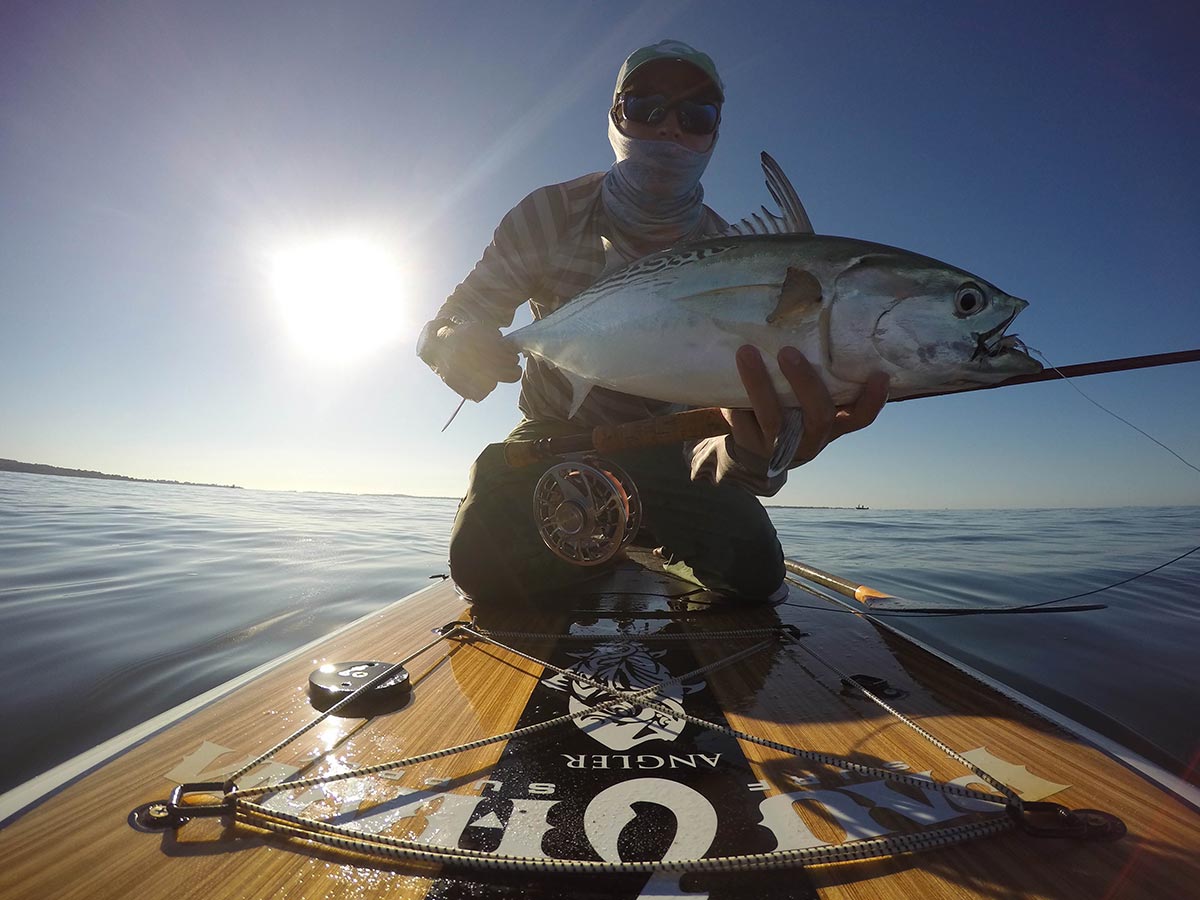
How To Hook ‘Em
Once you locate a pod of breaking fish, one method, of course, is to paddle hard toward the school and make a quick cast or two before it vanishes. Another technique is to simply drift near working fish, especially effective in staging areas like a small rip, estuary, bay, or perennial hotspots like Jordan Cove in Waterford, Connecticut. You can continuously blind cast around the board or just keep rod ready and loaded because, sooner or later, the fish should erupt within casting distance. Early mornings are your best bet because albies and bones are active then and the wind is usually calm.
Whether fishing with a companion or alone, SUP anglers must carry important safety gear to prevent a tragedy:
- Personal floatation device
- Charged cellphone in a sealed zip-lock bag or waterproof case
- Drinking water
- Signaling device
- Handheld, floating VHF marine radio
- Leave a “trip plan” at home
- Protective polarized eyewear
- Sunscreen
- Pliers
- Board leash
- Waterproof light/headlamp for evenings
As always with saltwater fly casting, your ability to cast the entire line quickly and accurately is paramount in success, especially off a board. An efficient fly caster will have an advantage over a spin angler because he or she can pick up their cast midway through a retrieve and quickly redirect the fly to fish breaking in a different direction or right next to the board.
A 9- or 10-weight, fast-action fly outfit with an intermediate line is a good choice for false albacore and bonito. Rig it with a 9-foot Fluorocarbon leader tapered to 12- to 16-pound test. Your reel choice is very important because these fish swim fast, so you need a smooth drag and plenty of backing. Fly choices start with a peanut bunker pattern about 3 inches long, but if you notice tiny bait spraying on the surface during a feeding frenzy switch to a 2- to 3-inch silverside or Clouser pattern with a narrow profile. And then hang on!
Photo Captions:
Sup_albies_main: One of the most exciting inshore gamefish challenges is tangling with big false albacore while standing on little more than a glorified surfboard!
Sup_albies02 OR sup_albies03: If you’ve never used a SUP before, the author highly recommends getting in some practice time without all your fishing gear before launching in search of breaking fish.
Sup_albies04: Fishing from a SUP is a great way to social distance and the rewards can be great.

